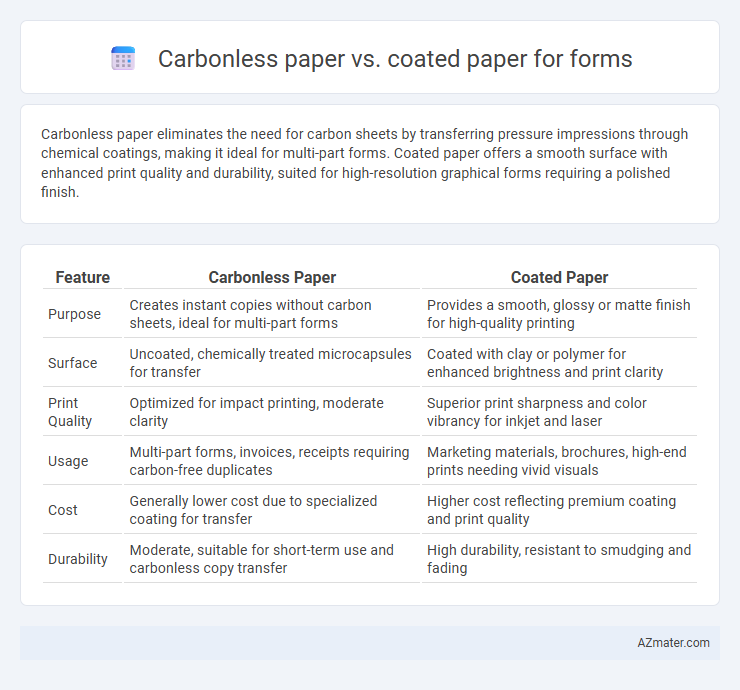Carbonless paper eliminates the need for carbon sheets by transferring pressure impressions through chemical coatings, making it ideal for multi-part forms. Coated paper offers a smooth surface with enhanced print quality and durability, suited for high-resolution graphical forms requiring a polished finish.
Table of Comparison
| Feature | Carbonless Paper | Coated Paper |
|---|---|---|
| Purpose | Creates instant copies without carbon sheets, ideal for multi-part forms | Provides a smooth, glossy or matte finish for high-quality printing |
| Surface | Uncoated, chemically treated microcapsules for transfer | Coated with clay or polymer for enhanced brightness and print clarity |
| Print Quality | Optimized for impact printing, moderate clarity | Superior print sharpness and color vibrancy for inkjet and laser |
| Usage | Multi-part forms, invoices, receipts requiring carbon-free duplicates | Marketing materials, brochures, high-end prints needing vivid visuals |
| Cost | Generally lower cost due to specialized coating for transfer | Higher cost reflecting premium coating and print quality |
| Durability | Moderate, suitable for short-term use and carbonless copy transfer | High durability, resistant to smudging and fading |
Introduction to Carbonless and Coated Paper
Carbonless paper is a chemical-coated material designed to transfer written information without the need for carbon sheets, commonly used for multi-part forms and invoices. Coated paper features a surface treated with a layer of clay or polymer to enhance print quality, often preferred for high-resolution graphics and text clarity. Both types serve distinct purposes in form production, with carbonless paper enabling immediate duplication and coated paper offering superior visual presentation.
What is Carbonless Paper?
Carbonless paper is a specialized type of paper designed to transfer information written on the top sheet to subsequent sheets without the need for carbon paper, using micro-encapsulated dye or ink that reacts upon pressure. It is widely used for multi-part forms such as invoices, receipts, and order forms, enabling instant duplicates and reducing manual copying errors. Compared to coated paper, carbonless paper uniquely facilitates self-copying capabilities critical for efficient form handling and record-keeping.
What is Coated Paper?
Coated paper features a surface layer of clay or polymer that enhances its smoothness, brightness, and ink holdout, making it ideal for high-quality printing and sharp image reproduction on forms. Unlike carbonless paper, which contains micro-encapsulated dyes to transfer marks without carbon sheets, coated paper provides a premium finish that resists smudging and improves readability in printed documents. This type of paper is preferred for professional forms requiring crisp graphics, vibrant colors, and a polished appearance.
Key Differences Between Carbonless and Coated Paper
Carbonless paper is designed for creating instant duplicate copies without the need for carbon sheets, using micro-encapsulated dye or ink that transfers under pressure, ideal for forms requiring multiple copies. Coated paper features a smooth finish achieved through a layer of clay or other substances, enhancing print quality and ink adhesion but does not produce duplicates on its own. The key difference lies in functionality: carbonless paper facilitates copy creation through chemical reaction, whereas coated paper improves visual print clarity and surface properties without duplicating content.
Best Use Cases for Carbonless Paper in Forms
Carbonless paper is ideal for multi-part forms requiring instant duplicate copies without the need for carbon strips, commonly used in invoices, receipts, and purchase orders. Its chemical coating enables clear transfers of writing pressure, making it perfect for businesses needing efficient record-keeping and client documentation. Unlike coated paper, carbonless paper provides immediate, legible duplicates, streamlining workflows in retail, logistics, and service industries.
Applications of Coated Paper for Business Forms
Coated paper is widely used for business forms requiring high-quality print results, such as invoices, purchase orders, and promotional mailers, due to its smooth surface that enhances ink sharpness and color vibrancy. Its resistance to smudging and improved durability make it ideal for multi-part forms and documents that must maintain clarity throughout handling. This paper type supports both laser and inkjet printing technologies, ensuring precise reproduction of barcodes, logos, and fine text critical for professional business communication.
Print Quality: Carbonless vs Coated Paper
Carbonless paper delivers sharp, clear impressions ideal for multi-part forms without the need for ink drying time, ensuring consistent print quality across duplicates. Coated paper offers a smooth surface that enhances color vibrancy and detail for single-sheet forms but requires longer drying times to prevent smudging. Selecting carbonless paper optimizes instant readability for multi-copy forms, while coated paper suits high-resolution, single-copy prints demanding superior color and gloss.
Cost Comparison: Carbonless vs Coated Options
Carbonless paper typically costs more upfront due to its specialized chemical coating that enables instant duplicate copies without carbon sheets, whereas coated paper generally has a lower base price but requires additional carbon sheets for multi-part forms. Over time, carbonless paper reduces operational costs by eliminating the need for separate carbon inserts, making it more cost-effective for high-volume form printing. Choosing between carbonless and coated paper hinges on balancing initial material costs against long-term efficiency and usage frequency.
Environmental Impact and Recyclability
Carbonless paper, designed for multi-part forms without carbon sheets, offers better recyclability as it lacks plastic coatings and chemical residues common in coated paper. Coated paper, often treated with clay or polymer layers to enhance print quality and durability, typically poses greater environmental challenges due to reduced biodegradability and more complex recycling processes. Choosing carbonless paper supports sustainability goals by minimizing chemical waste and facilitating easier incorporation into standard paper recycling streams.
How to Choose the Right Paper for Forms
Choosing the right paper for forms depends on the purpose and end-use requirements; carbonless paper is ideal for creating instant multi-part copies without the need for carbon sheets, offering convenience for invoices and receipts. Coated paper provides a smooth, polished surface that enhances print clarity and durability, making it suitable for high-quality forms requiring sharp graphics and text. Evaluate the need for copy duplication, print quality, and handling preferences to determine whether carbonless or coated paper best suits your form's functionality.

Infographic: Carbonless paper vs Coated paper for Form
 azmater.com
azmater.com